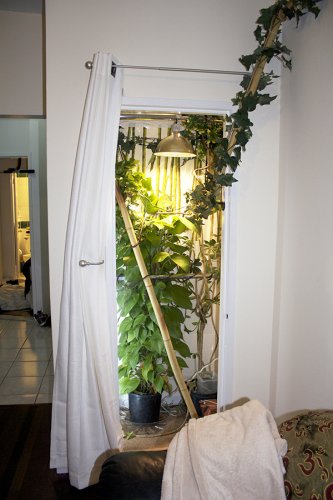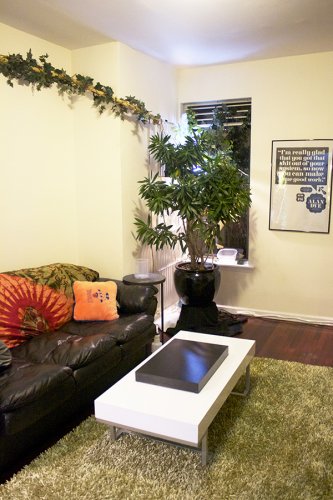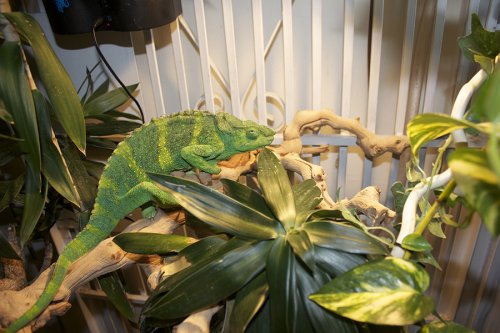CauseNAffect
Member
Haven't posted in a while, but wanted to share my observations and experiences with chameleon efforts.
I began with a rescue Melleri named Olive, living in New York City, who was about 3 years old. His original setup was a reptibreeze large enclosure, hooked up with all the trimmings. After he got larger, I always had the desire to give him more room to live a more active life and be the giant reptile that he was. I also hated the science project look of a lot of the enclosures I see posted here / ones I created in the past. So, I decided to build a gigantic free range system in the living room of my apartment. My chameleon lived in it for 4.5 years in this setup before ultimately passing away last night.
THE SETUP (pictures below):
I turned my full closet into an enclosure filled with live plants, all lighting and misting equipment, and dripper... I then created a bamboo and vine covered walkway along my ceiling connecting my closet, to another plant located by the window with a perch and it's own basking light / misting system for basking and to look out the window, which he did often. The room was very low traffic considering I was the only person living in the apartment and didn't have guests over often. I typically kept the room around 78degrees and 68 at night. My basking temps, drippers, gutloading / variety of feeding, and overall visible health of the chameleon was fantastic and consistent for years. Like a well oiled machine. I would feed phoenix worms, dubias, crickets, hornworms, and even tried hatching mantis eggs (which is an insanely interesting and fun experience, which I ended up not feeding because I enjoyed them so much, like many of the insects I came to love.) Like any chameleon owner I tried new things and experimented to dial in my setup to best serve my cham.
THE BEHAVIOR:
He was an extremely active and curious cham, but not very social. He tolerated my existence, but quietly despised it, and over the years became more accepting of me handling him. I would often would find him in various places around the apartment, and most frequently... he would rest in the area marked "typical location" with the red circle. I believe he sat here because it gave him the highest and widest possible view of the room for his safety and protection, and overall peace of mind.
Lifetime breakdown of locations in which I found the cham when returning home from work:
Most of the behavior my chameleon exhibited I believe was simply to put himself in the best position for his own safety, get light by the window, or to get closer to the shower (where I would have another tree setup for him at night, in case he didn't drink from the dripper).
THE PROBLEM:
My chameleon unfortunately developed gout, which he lived with for nearly 8 months. It became increasingly severe, up until his death. How could this be I thought... I've done EVERYTHING. I've checked literally every box you could as an owner and with his setup / feeding. He has mist shooting and water dumping on the leaves around him everyday, along with a shower around 4-5 times a week. I changed out his lights every year and dusted his feeders by the book with Calcium without d3 everyday and Calcium with d3 about twice a month. All his basking spots and hangouts had lighting within proper distance of his locations.
THE ANALYSIS:
At the end of the day, I can only offer theories based on my time with this kind of setup.
I think that the 35% of time spent in the middle location of the walkway + the 12% of the time spent in random locations = 47% of my chameleons life that he spent away from UVB lighting / direct sunlight / water. I think that all of these things including hydration, calcium conversion from uvb and other possible things I might not be considering contributed to the gout and eventual death of my chameleon.
RECOMMENDED FREE RANGE:
At the end of the day, I believe that my setup, although large and very spacious for a giant Melleri Chameleon, was not what any chameleon needs, no matter how large. Natural sunlight I believe to be the best possible thing for a chameleon considering it is how they survive in the wild. In my opinion, when you are creating your own environment in a large space it is simply impossible to provide a chameleon the right balances of lighting that allows the creature to process its food and nutrients properly. In my opinion, the ideal setup is a cage simply out in direct sunlight in a warm weather climate, secondarily would be a mesh enclosure with a lighting setup to develop consistency in seasonal climates like mine in NYC. I think that although free ranging a chameleon is great, it should be done in a much more controlled manner than what I attempted to do. The name of the game to keeping chams is CONSISTENCY. I simply don't think that chameleons can discern well enough when they need UVB / hydration for the kind of setup I have to get the regular amounts they need. A controlled environment with constant exposure to proper lighting for a chameleon in a moderately sized cage would create the ideal consistency for a creature that needs these elements to survive. Although they aren't super attractive, they would've served my chameleon better despite not offering much less space. It simply couldn't establish the right consistency considering the chameleon was all over the damn place.
If you do wish to free range your chameleon: I would suggest doing so in a controlled manner in direct sunlight first and foremost, or simply when you come home from work. I would never let a chameleon have the space mine did to simply decide where he goes... I can guarantee they will not decide correctly.
Hopefully this helps someone somehow. I'm sad I lost my friend.
MY FREE RANGE WHEN I FIRST SET IT UP:




I began with a rescue Melleri named Olive, living in New York City, who was about 3 years old. His original setup was a reptibreeze large enclosure, hooked up with all the trimmings. After he got larger, I always had the desire to give him more room to live a more active life and be the giant reptile that he was. I also hated the science project look of a lot of the enclosures I see posted here / ones I created in the past. So, I decided to build a gigantic free range system in the living room of my apartment. My chameleon lived in it for 4.5 years in this setup before ultimately passing away last night.
THE SETUP (pictures below):
I turned my full closet into an enclosure filled with live plants, all lighting and misting equipment, and dripper... I then created a bamboo and vine covered walkway along my ceiling connecting my closet, to another plant located by the window with a perch and it's own basking light / misting system for basking and to look out the window, which he did often. The room was very low traffic considering I was the only person living in the apartment and didn't have guests over often. I typically kept the room around 78degrees and 68 at night. My basking temps, drippers, gutloading / variety of feeding, and overall visible health of the chameleon was fantastic and consistent for years. Like a well oiled machine. I would feed phoenix worms, dubias, crickets, hornworms, and even tried hatching mantis eggs (which is an insanely interesting and fun experience, which I ended up not feeding because I enjoyed them so much, like many of the insects I came to love.) Like any chameleon owner I tried new things and experimented to dial in my setup to best serve my cham.
THE BEHAVIOR:
He was an extremely active and curious cham, but not very social. He tolerated my existence, but quietly despised it, and over the years became more accepting of me handling him. I would often would find him in various places around the apartment, and most frequently... he would rest in the area marked "typical location" with the red circle. I believe he sat here because it gave him the highest and widest possible view of the room for his safety and protection, and overall peace of mind.
Lifetime breakdown of locations in which I found the cham when returning home from work:
12% random locations (shoe rack by the door, by the bed, couch, on the ground roaming, hiding in the leaves in his bushes)
35% center spot on his bamboo walkway
53% under basking light
35% center spot on his bamboo walkway
53% under basking light
Most of the behavior my chameleon exhibited I believe was simply to put himself in the best position for his own safety, get light by the window, or to get closer to the shower (where I would have another tree setup for him at night, in case he didn't drink from the dripper).
THE PROBLEM:
My chameleon unfortunately developed gout, which he lived with for nearly 8 months. It became increasingly severe, up until his death. How could this be I thought... I've done EVERYTHING. I've checked literally every box you could as an owner and with his setup / feeding. He has mist shooting and water dumping on the leaves around him everyday, along with a shower around 4-5 times a week. I changed out his lights every year and dusted his feeders by the book with Calcium without d3 everyday and Calcium with d3 about twice a month. All his basking spots and hangouts had lighting within proper distance of his locations.
THE ANALYSIS:
At the end of the day, I can only offer theories based on my time with this kind of setup.
I think that the 35% of time spent in the middle location of the walkway + the 12% of the time spent in random locations = 47% of my chameleons life that he spent away from UVB lighting / direct sunlight / water. I think that all of these things including hydration, calcium conversion from uvb and other possible things I might not be considering contributed to the gout and eventual death of my chameleon.
RECOMMENDED FREE RANGE:
At the end of the day, I believe that my setup, although large and very spacious for a giant Melleri Chameleon, was not what any chameleon needs, no matter how large. Natural sunlight I believe to be the best possible thing for a chameleon considering it is how they survive in the wild. In my opinion, when you are creating your own environment in a large space it is simply impossible to provide a chameleon the right balances of lighting that allows the creature to process its food and nutrients properly. In my opinion, the ideal setup is a cage simply out in direct sunlight in a warm weather climate, secondarily would be a mesh enclosure with a lighting setup to develop consistency in seasonal climates like mine in NYC. I think that although free ranging a chameleon is great, it should be done in a much more controlled manner than what I attempted to do. The name of the game to keeping chams is CONSISTENCY. I simply don't think that chameleons can discern well enough when they need UVB / hydration for the kind of setup I have to get the regular amounts they need. A controlled environment with constant exposure to proper lighting for a chameleon in a moderately sized cage would create the ideal consistency for a creature that needs these elements to survive. Although they aren't super attractive, they would've served my chameleon better despite not offering much less space. It simply couldn't establish the right consistency considering the chameleon was all over the damn place.
If you do wish to free range your chameleon: I would suggest doing so in a controlled manner in direct sunlight first and foremost, or simply when you come home from work. I would never let a chameleon have the space mine did to simply decide where he goes... I can guarantee they will not decide correctly.
Hopefully this helps someone somehow. I'm sad I lost my friend.
MY FREE RANGE WHEN I FIRST SET IT UP:










